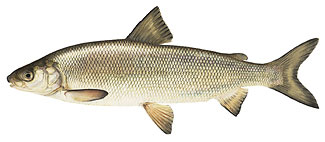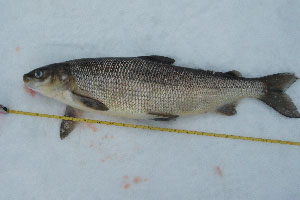Lake Whitefish
Coregonus clupeaformis
 Distribution: Lake whitefish are found throughout Alaska and Canada, south to the Great Lakes Region, and east to northern New England. The species has been introduced into Montana, Idaho, and Washington. In New Hampshire, lake whitefish are thought to currently inhabit a number of cold water lakes, including Lake Winnipesaukee, Squam Lake, Winnisquam Lake, Lake Wentworth, Silver Lake (Madison), Ossipee Lake, and the Connecticut Lakes. Lake white fish were stocked into a number of waterbodies in the 1800s and may only be native to Lake Winnipesaukee.
Distribution: Lake whitefish are found throughout Alaska and Canada, south to the Great Lakes Region, and east to northern New England. The species has been introduced into Montana, Idaho, and Washington. In New Hampshire, lake whitefish are thought to currently inhabit a number of cold water lakes, including Lake Winnipesaukee, Squam Lake, Winnisquam Lake, Lake Wentworth, Silver Lake (Madison), Ossipee Lake, and the Connecticut Lakes. Lake white fish were stocked into a number of waterbodies in the 1800s and may only be native to Lake Winnipesaukee.
Description: The lake whitefish is an elongated silvery fish with a small head compared to its body, which creates a hump-like appearance. Its large scales slough off easily when handled. The mouth is small and toothless, with the upper jaw overhanging the lower. There is a double flap of skin between the nostril openings. Coloration ranges from silver or satin along the sides to olive green on the back. Both sexes develop conical tubercles, or pearl organs, which create a rough, bumpy appearance during the spawning season.
Species commonly confused with: Fallfish
Habitat: Deep, cold water lakes and large cool rivers.
Life History: Lake whitefish travel in schools, feeding close to the bottom on small invertebrates, fish eggs, and zooplankton. Small fish, such as smelt, are included in the diet of larger individuals, but their small delicate mouths limit the size of their prey. The small mouth also explains why lake whitefish are rarely caught by anglers who are not specifically targeting the species. Lake whitefish were once a very popular sportfish in New Hampshire, but their popularity has faded over time. They are still the target of commercial fisherman in the Great Lakes and Canada due to their excellent tasting flesh.
Lake whitefish spawn in the late fall, at temperatures between 40°F and 50°F, over shallow, rocky reefs with access to deeper water. After fertilization, the eggs settle into crevices among the rocks and the larvae hatch in late winter. Very little is known about the extent of lake whitefish spawning habitat in New Hampshire.
Lake whitefish seek out cool water at depths during the summer months. Although capable of reaching weights up to 20 pounds, 1 to 2 pound fish are more typical of New Hampshire waters.
Origin: Native

Conservation/Management: Lake whitefish are difficult to study due to their preference for deep water and their relatively short spawning season. Other than the occasional anecdotal angler report, there is very little current information on the status of lake whitefish in New Hampshire.
As a cold water fish species, lake whitefish are potentially vulnerable to the impacts of climate change. There may be a reduction in the total area and water quality of deep, cold water habitat in lakes and ponds that support cold water fish species. Lake whitefish populations in lakes and ponds are also vulnerable to the impacts of pollution, such as nutrient loading and acid or mercury deposition. As with the lake trout, its dependence on shallow reef habitat for spawning makes the lake whitefish vulnerable to water level draw down during winter. To avoid exposing lake whitefish eggs, draw-downs should be completed before the spawning season.



